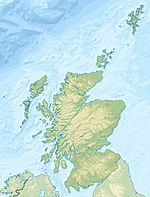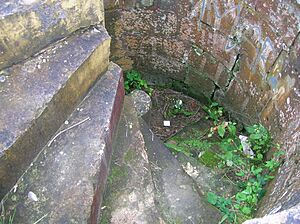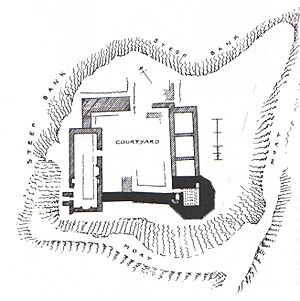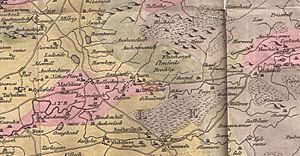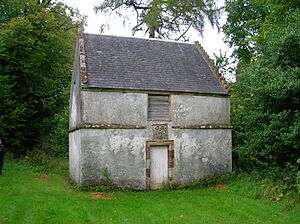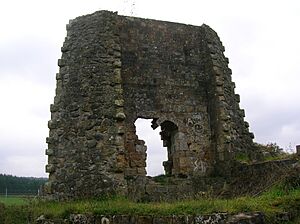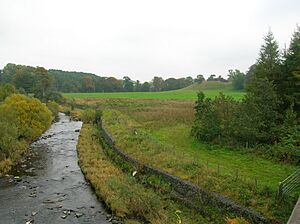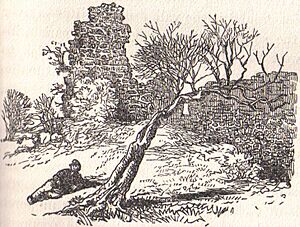Terringzean Castle, East Ayrshire facts for kids
Quick facts for kids Terringzean Castle |
|
|---|---|
| Cumnock, East Ayrshire, Scotland GB |
|
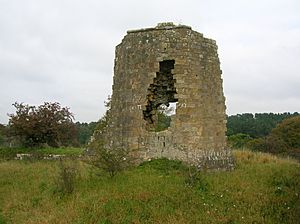
Terringzean Castle from the west
|
|
| Coordinates | 55°27′25″N 4°17′08″W / 55.45687°N 4.28561°W |
| Site information | |
| Owner | Private |
| Open to the public |
No |
| Condition | Ruin |
| Site history | |
| Built | Circa 1696 |
| Built by | Campbells of Loudoun |
| In use | 18th century |
| Materials | Stone |
Terringzean Castle, also known as Taringzean (pronounced 'Tringan'), is a ruined castle in Scotland. It is a Category B listed site, meaning it's an important historical place. The castle sits high above the River Lugar near Dumfries House in Cumnock, Scotland. It was sometimes called Craufordstone or Craufurdstoun because the Crawford family once owned the land. Another castle, Lefnoreis Castle (or Lochnorris Castle), which was also owned by the Crawfords, used to stand near where the stables of Dumfries House are today.
Contents
Discovering Terringzean Castle's Past
The area where Terringzean Castle stands was covered with hawthorn trees in the late 1800s. The castle's name has been spelled many different ways over time, like 'Trarizeane' and 'Terrinzeane'.
What Terringzean Castle Looks Like
Terringzean Castle is built on top of a very steep bank. This spot gives it a great view over the River Lugar. To protect the castle from attacks, there was a dry moat (a ditch without water) on the flatter sides. This moat is still visible today. It was made clearer by excavations (digging work) done in the 1890s by the 3rd Lord Bute.
The oldest part of the castle is a small, eight-sided tower from the 14th century. It is about 6 meters (20 feet) tall and has very thick walls, about 2 meters (6.5 feet) wide. This tower had a vaulted ceiling with three stone ribs. You could enter the tower from the courtyard through a narrow passage. This passage led to a spiral staircase, parts of which still remain. There were also other buildings and a well inside the castle area. The castle ruins have been partly restored, and you can still see where the digging trenches were.
The castle ruins suggest it was a "castle of enceinte" (a castle with a strong outer wall), similar to Loch Doon Castle. Before this walled castle, there might have been an even older building, possibly a medieval hall house from the 13th century. Some experts have noticed that Terringzean's tower looks like the tower at Mugdock Castle.
Who Owned Terringzean Castle?
Over the centuries, many different families owned Terringzean Castle and its lands.
The Craufurds: First Owners
The first mention of Terringzean is from 1438, but it didn't mention the castle itself. The Craufurd family was the first recorded owner of the castle and lands. Their family symbol was a Stag's Head. They also owned Lefnoreis Castle, where Dumfries House now stands. Only the old dovecot (a building for pigeons) from Lefnoreis Castle still exists today.
The Craufurds stopped owning Terringzean by 1467. The land then went to Thomas Boyd, Earl of Arran. At this time, the castle was called 'Craufuirdstone, also Terringzeane'. The Craufurds of Terringzean were related to the mother of Sir William Wallace, a famous Scottish hero.
The Boyds: A Royal Connection
Thomas Boyd, Earl of Arran lost favor with King James III. Even though he was married to Princess Mary, the King's sister, the King took his lands in 1469. These lands were then meant for the first-born princes of Scotland. In 1488, a man named Thomas Turnbull was given the castle for his good service to the King.
The Ramsays: Friends of the King
In 1488, Sir John Ramsay held the castle and lands for his lifetime. He was a close friend of King James III. He was lucky to survive when other friends of the King were executed. He was once Lord of Bothwell and was an ancestor of the Balmain family. William Ramsay of Balmain was given the lands in 1534.
The Campbells: A Powerful Family
In 1546, Hugh Campbell, Earl of Loudoun, took over the lands. Other Campbells continued to own the castle, including Sir John Campbell and his wife Margaret Campbell in 1621.
The Crichton-Stuarts: New Owners
The Crichton-Stuarts, who were the Earls of Dumfries, bought the lands and the castles of Craufuirdstone and Lochnorris from the Campbells of Loudoun in 1696. The Earl of Loudoun still has the smaller title of Lord Taringzean today.
Other Owners Over Time
Many other people owned parts of the land around Terringzean Castle for shorter periods. These included Hugh Montgomerie in 1647, James Reid in 1666, Sir George Campbell in 1691, and Sir James Carmichael in 1692. Finally, in 1696, John, Viscount Stair, and then the Earls of Dumfries (who later became the Marquis of Bute) took ownership.
Terringzean Castle Today
In 2007, a group led by the Prince of Wales (now King Charles III) bought Dumfries House and its large estate, which includes Terringzean Castle. This group included charities that protect historical sites and the Scottish Government.
Quick Facts About Terringzean
- In 1587, Hew Campbell of Terringane was asked by the Scottish parliament to inspect bridges and harbors.
- A map from 1747–55 by William Roy shows 'Torringan' and nearby woodlands.
- Armstrong's map from 1775 already shows Terringzean Castle as a ruin.
- 'The Avenue' was a road that led from Cumnock past Terringzean Castle to Dumfries House.


